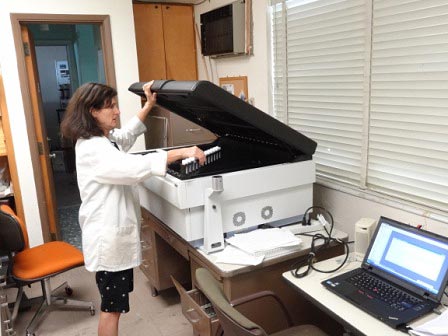General Comments
After almost 30 years into this project, we have a stable routine for collecting and measuring samples for the purpose of finding extremely low contamination levels. At the request of ship operator, scientist, or directly by NSF Ship Facilities Office, we will send a technician to any port in the US to obtain samples. The initiating person will be notified of the SWAB test results, as soon as the samples are returned to our laboratory and counted. In particular, we will notify the initiator immediately by phone if we find a sample at potential health hazard levels. Reports will be circulated to interested parties. These include the NSF Oceanographic Technical Services Program Office and the initiator of the SWAB request.
The Tritium Lab can also advise in planning the renovation and/or building of radioisotope vans with radiation safety in mind. Through our experience with causes of spills and clean up problems encountered, we can make suggestions as to what materials to use when building workbenches and sinks; selecting floor coverings; and addition of general structural changes in the van such as isolation areas for changing shoes and lips on workbenches to retain spills. It is also important that radiation vans never be used for anything other than radiation work. We strongly recommend that radiation vans never be used as shipping and storage containers, especially for sampling gear such as Niskin Bottles, Moc Ness, etc.
During the last several years, there have been 23 cases of 3H and/or 14C contamination. However, of these, only two were actual ship contamination. The remainder occurred in radioisotope vans or in land-based laboratories. These scenarios make an excellent argument in favor of radioisotope work being done exclusively in vans and never allowed in shipboard labs.
Test Results and Subsequent Action
Our recommendation for action is based on the scientific community’s requests. Many PI’s who measure natural abundances of 3H and 14C consider any value above our detection limit of 100 dpm/m2 evidence of contamination and will clean up the area even if the SWAB protocol does not recommend cleaning. The increasing sensitivity and precision of mass spectrometer measurement techniques allow researchers to accurately measure increasingly smaller magnitudes and differences in 3H and 14C. This requires that any possible contamination be kept to a minimum. Also, the bomb-produced signals for 3H and 14C are becoming increasing difficult to measure due to dilution and, in the case of 3H, significant radioactive decay.

Comments on SWAB reports
Technical data below applies unless otherwise indicated.
Typical instrument background for tritium and C14: 7 and 15 cpm, respectively.
All data are means of at least three runs and are expressed in dpm/m2 extracted; machine and wash solution blanks have been subtracted.
Typical error: ±10% or ±50 dpm/m2, whichever is larger, for both tritium and 14C.
Criteria for SWAB Results
| Category |
Tritium (dpm/m2) |
C14 (dpm/m2) |
|
| A |
< 500 |
< 50 |
No action |
| B* |
500 – 10,000 |
50-10,000 |
Needs cleaning before natural tracer work. No health hazard. Does not apply to Radiation Vans.
|
| C** |
10,000 – 100,000 |
10,000 – 50,000 |
Must be cleaned before any use. Includes Radiations Vans.
|
| D*** |
>100,000 |
>50,000 |
May be a health hazard. Notify local Radiation Safety Official.
|
Test Results and Subsequent Action
Our recommendation for action is based on the scientific community's requests. Many PI’s who measure natural abundances of 3H and 14C consider any value above our detection limit of 100 dpm/m2 evidence of contamination and will clean up the area even if the SWAB protocol does not recommend cleaning. The increasing sensitivity and precision of mass spectrometer measurement techniques allow researchers to accurately measure increasingly smaller magnitudes and differences in 3H and 14C. This requires that any possible contamination be kept to a minimum. Also, the bomb-produced signals for 3H and 14C are becoming increasing difficult to measure due to dilution and, in the case of 3H, significant radioactive decay.
| <500 dpm/m2 for both 3H and 14C. |
|
| 500 to 10,000 dpm/m2 for both 3H and 14C. |
The area must be cleaned before any natural abundance tracer work is conducted (does not apply to radiation vans).
|
| >10,000 dpm/m2 for both 3H and 14C. |
The area must be cleaned before any use (applies to radiation vans as well as ships and laboratories).
|
| >100,000 and 50,000 dpm/m2 for 3H and 14C, respectively. |
Indicates a possible health hazard, and Radiation Safety authorities from requesting institution will be immediately notified.
|




